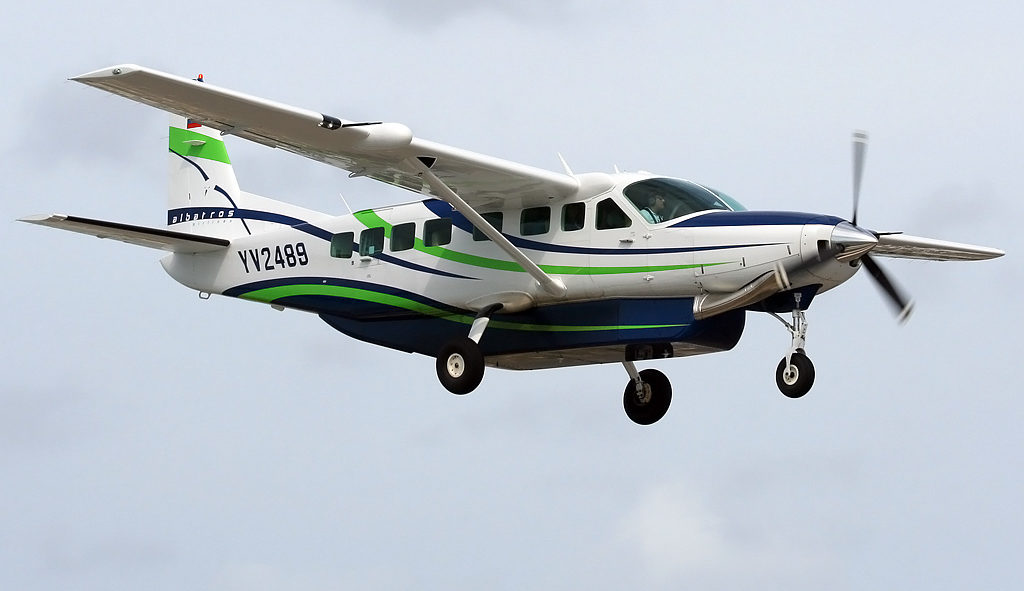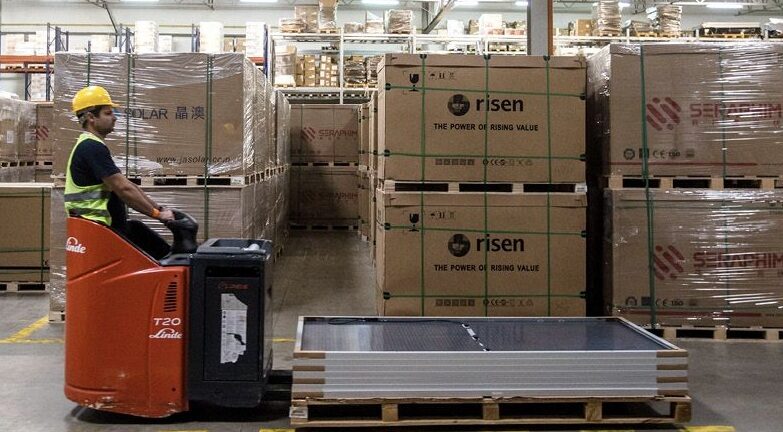From pv magazine Australia.
No matter how keen we may be to resume travel, Covid-19 has likely dampened our enthusiasm for flying in confined spaces with hundreds of others. Touchdown the nine-seater Cessna eCaravan, powered entirely by an electric motor engineered by magniX on the Gold Coast in Queensland, which on Friday made its maiden half-hour flight at Moses Lake, in Seattle in the U.S.
The great leap forward in electric propulsion for aviation has come at a time when “the drive to smaller aircraft, lower cost, more convenience and cleaner-for-the-environment [flights]” are coinciding, according to Roei Ganzarski, CEO of Singapore-owned magniX, who was talking to British broadcaster the BBC in the wake of last week’s flight.
The eCaravan won’t get you from Perth to London, but magniX’s stated purpose has always been to connect communities via zero-emission, low-cost flight, and Ganzarski expects the eCaravan to be in commercial use next year.
The plane’s successful half-hour, 160km test flight used less than US$6 worth of electricity. Compare that to a Cessna Caravan powered by a conventional combustion engine which would have sucked up some US$300-400 worth of fuel. As Ganzarski pointed out, the motor requires very little maintenance compared to its gas-guzzling cousins, just as with electric cars.
Invented in Australia
At its Gold Coast facility in 2017, magniX – which is owned by Singaporean conglomerate Clermont Group – solved a number of challenges confronting the design of an electric-powered aircraft motor. The engine maker subsequently ran eight versions in rugged conditions, at all temperatures and for more than 1,000 hours, to stress-test reliability. In late 2018, the magniX team began using the motor to turn aircraft propellers and then unplugged from the wall to demonstrate that propulsion capability could be based purely on battery power. “That was a very significant milestone,” Ganzarski told pv magazine last year.
With its 2017 breakthrough into aircraft capability, magniX established a second base in Seattle, a global hub of aviation development. There, local aviation company AeroTec modified a Cessna Caravan to fly under magniX electric propulsion.
Ganzarski decided to retrofit the electric motor on the basis the Cessna frame is already approved by the U.S. Federal Aviation Administration, which should advance certification of an e-model of the same aircraft.
An industry revolution
Demonstrating a commercially viable electric aircraft, the magniX chief executive told the BBC, is the only way to inspire battery companies to design products for aviation by pushing the envelope on weight, capacity and range. Conversely, Ganzarski believes aviation batteries will spur aerospace companies to come up with lighter aircraft designed for electric flight.
The Israeli-designed Eviation Alice, for example, shows how the different weight and thrust of electric motors are enabling aircraft of revolutionary shape and configuration. Eviation, like magniX, is wholly owned by the Clermont Group belonging to New Zealand-born billionaire Richard Chandler.
Ganzarski told pv magazine last year: “If you were to take a by-design-nine-passenger, all-electric aircraft you could, with today’s batteries, achieve something like 500 miles [800 km] in range … We’re working on both paths, because if we were only to work on new electric craft, the adoption into the industry would be much slower.”
MagniX in December conducted the successful test flight of a modified de Havilland Canada DHC-2 Beaver seaplane powered by the same 750hp motor as was fitted to the eCaravan.
The electric aviation engine maker won the 2020 Fast Company Most Innovative Company in Energy prize and was a finalist in the 2020 Fast Company World Changing Ideas in Transportation awards.
Regional benefits
With magniX estimating 45% of global flights are of less than 800km – and 5% sub-160km – it is likely commercial electric flights powered by magniX motors will first be offered in Europe, the U.K. and the U.S. However, Ganzarski offered a vision of what even short-range flights could mean for regional Australian towns.
“You could have phenomenal factories or businesses in these places that can’t currently sell their goods or can’t receive goods, because the 4.5 to six-hour truck drive that happens maybe once a week is just [operationally] prohibitive,” said the CEO. “If you could have an aircraft do that in 20, 40, 60 minutes, and do it with zero emissions at a really low cost … suddenly you’re really connecting these communities.”
With the engine company claiming up to half of airline operating costs are consumed by fuel and engine maintenance, the e-flight pioneers have said their engines could reduce overall costs up to 80% per flight hour.
Add solar rooftops to all regional airports, and Tritium super-fast electric vehicle chargers, and you have the ingredients for job creation and regional regeneration and reconnection in the wake of Covid-19. Simplistic perhaps, but not science fiction, and certainly not the only potential offered by electrically-powered flight.
“One of the things we’re trying to do is not just make flying cheaper but to make it so efficient and so low-cost from an operating perspective, that new operating models could start up that will change the way we think today.” The magniX boss might be onto something.
Sustainability in solar and storage
This copy was amended on 03/06/20 to reflect the town in Seattle mentioned is called Moses Lake, rather than Lake Moses.
This content is protected by copyright and may not be reused. If you want to cooperate with us and would like to reuse some of our content, please contact: editors@pv-magazine.com.




Complete waste of time and money. No ROI. Battery technology isn’t up to the requirements for replacement of internal combustion engine.
Attach a balloon to it and maybe it will stay up then.
You didn’t read the bit about Alice with a 500 mile range and operating costs half to 1/3rd that of a ICE plane then, not to mention curfew busting low noise emissions, less support crew required
This is a great development for so many reasons. Apart from the reduced CO2 emissions, electric aircraft produce way less noise pollution than hydrocarbon-fuelled aircraft. Another lesser known problem with small ICE propeller-driven aircraft is that they still use leaded fuel (due to the need for extra-high octane ratings when flying in the thinner air found at high altitude). Replacing leaded fuel with electricity would reduce lead exposure for those of us living near regional airports. This is especially important for children’s’ health.
Electric aircraft will be very important for islands which cannot be connected by electric cars or rail. Take for example the busy Dublin, Ireland to Manchester, England route which, at 218 km, could be well within the range of electric flight before too long. I wish great success to all companies working on electric flight.
The “that will never work” crowd jumps on the change to new technology with every innovation introduction. Electric cars were “not viable”. Electric trains would “never replace diesel locomotives”. Autopilot systems would “never be trusted to fly planes beyond the most rudimentary conditions”. Yet, here we are with electric cars that have 400 mile ranges, in use. Electrified rail is the standard in high speed rail travel. Flight management computers managing routes, waypoints, altitudes, speeds, and GPS approaches.
This is only the beginning of electric motor driven aviation. Bravo to the innovators!
The town is called ‘Moses Lake’.
Thanks Frank,
Absolutely right and rather embarrassing for us given its solar industry links. The copy will be amended forthwith and my wrists duly slapped.
Roger that.
Great Almighty have blessed the skys with clean environment
Great job
Great idea
Great skys
Great Aviation
Great to be a admirer of new interventions
Great to be one of a few to travel safely in safe electric flight
Due respects for future safety success god willing
Regards good luck
Dr Suhail Mohammed Abdush Shaheed
The immediate need in aviation engines is the replacement 180 HP and 285 HP Avgas guzzling 4 & 6 cylinder steel block with updraught carburettor or less than automotive quality injection system. handicapped to magnetos (yes… magnetos) for ignition. Absolutely archaic. And these engines are only good for 2,000 hours with an overhaul cost or $45,000!!! Please produce an engine of similar horsepower with less weight and complexity and a 5 hour running time. You will have an immediate market. Fit the engine into the same engine mounts with lighter wiring, no hoses, smaller lubrication system. Bring back the wind generator so the batteries can recharge during flight. Please. Gary